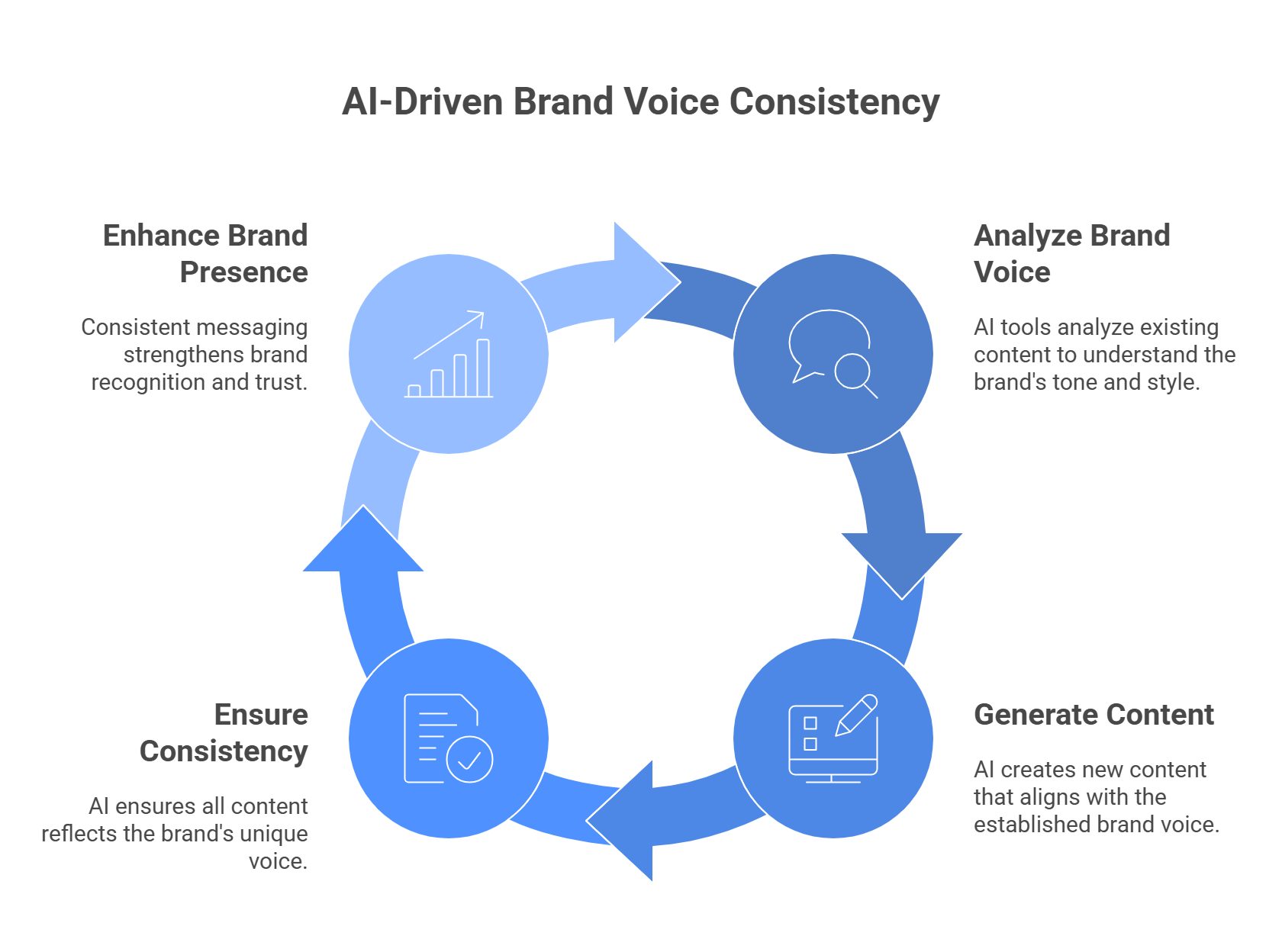In a digital world flooded with content, how does your brand avoid sounding like just another robot? With the rise of artificial intelligence, the risk of creating generic, soulless content is higher than ever. But the answer isn’t to ditch AI—it’s to master it. A powerful, authentic brand voice is no longer a “nice-to-have”; it’s your most critical asset for cutting through the noise, building trust, and driving revenue.
This comprehensive guide will provide you with “The Authenticity Algorithm”—a strategic framework for commanding AI to speak your unique language. We’ll deconstruct the DNA of your brand, build a practical workflow for human-AI collaboration, and explore the future of brand personality. Let’s dive in.

The Strategic Imperative of Brand Voice in the Digital Ecosystem
In an economic landscape increasingly saturated with content, a brand’s voice is no longer a peripheral marketing asset but a central pillar of its strategic architecture. The proliferation of artificial intelligence in content creation has amplified this reality, transforming a consistent and authentic brand voice from a competitive advantage into a fundamental prerequisite for market relevance. This section will deconstruct the core concepts of brand communication, establish the commercial case for unwavering consistency, and frame the strategic imperative for mastering brand voice in an AI-driven world.
Defining the Core Concepts: Voice, Tone, and Personality
To effectively command artificial intelligence, a precise understanding of the foundational elements of brand communication is essential. These concepts—voice, tone, and personality—are distinct yet interconnected, forming the DNA of how a brand presents itself to the world.
- Brand Voice is the unique, consistent personality that a brand embodies in all its communications. It is the unchanging core of the brand’s character, deeply rooted in its mission, values, and overarching purpose. Brand voice is not about what a brand says, but how it says it, consistently, across every channel and touchpoint. It is the defining feature that makes a brand recognizable and memorable.
- Brand Tone, while closely related, is the emotional inflection of the brand’s voice, which adapts to specific contexts and situations. If brand voice is the enduring personality, brand tone is the way it modulates its expression based on the conversation. A brand’s voice might consistently be helpful and expert, but its tone will shift from playful on TikTok to serious and empathetic in a customer complaint resolution.
- Brand Personality is the humanization of the brand—a set of human characteristics associated with it. It answers the question: If the brand were a person, what would they be like? Nike, for instance, employs a commanding, empowering, and strong voice to establish an identity of athletic achievement. Dove, conversely, uses a supportive, sincere, and reliable voice to champion real beauty and self-esteem.
As the marginal cost of content creation plummets towards zero, the digital ecosystem will inevitably become flooded with generic, grammatically correct, but soulless content. In this environment, consumers will develop a form of “genericity blindness,” instinctively tuning out any communication that lacks a distinct and authentic personality.

The Commercial Case for Consistency: From Trust to Revenue
Maintaining a consistent brand voice is not an exercise in creative vanity; it is a critical business function that directly impacts customer perception, loyalty, and ultimately, revenue.
- Building Recognition and Trust: Consistency is the bedrock of trust. When a brand communicates with a steady and recognizable voice, it becomes familiar to consumers. This familiarity breeds a sense of reliability and predictability, which are essential for building deep, emotional connections.
- Driving the Customer Journey: A consistent brand voice is a powerful force multiplier at every stage of the customer journey, from building Awareness and Consideration to driving Conversion and ensuring long-term Retention.
- Creating a Competitive Moat: In over-saturated markets, a unique brand voice can be the single most powerful differentiator. It allows a brand to carve out a distinct space in the consumer’s mind, capturing attention and driving preference in a way that feature-for-feature comparisons cannot.
The distinction between voice and tone is the single most critical concept for successful AI integration. AI models excel at contextual adaptation (tone) but struggle to grasp the inherent essence of a personality (voice) unless explicitly trained. A successful strategy must begin by defining the core voice as a constant and then providing a clear, logical framework for tonal adaptation.

Deconstructing Your Brand’s DNA: A Framework for Creating a “Brand Voice Bible”
To command an AI to speak with a consistent voice, that voice must first be rigorously deconstructed, analyzed, and codified. This process culminates in the creation of a “Brand Voice Bible”—a comprehensive document that serves as the single source of truth for all content creators, both human and artificial.
The Internal Audit: Defining Your Mission, Vision, and Values
An authentic brand voice must be an expression of the organization’s core purpose. This stage involves deep engagement with key stakeholders to answer fundamental questions:
- Who are you? Describe the company in a single, simple sentence.
- What do you do? Explain the company’s function in a single, simple sentence.
- What makes you unique? List three key differentiators.
- What are your core values? Identify the three most important principles that guide the business.
The External Audit: Understanding Your Audience and Competitive Landscape
Once the internal foundation is set, the focus shifts outward. A brand voice does not exist in a vacuum; it must resonate with its intended audience and stand apart from its competitors. This requires detailed Audience Analysis through buyer personas and Competitor Voice Mapping to identify “white space”—values, tones, and personality traits that are being underutilized.
Synthesizing the Voice: From Abstract Values to Concrete Characteristics
This stage translates abstract findings into a concrete, actionable voice profile. Based on internal values, audience preferences, and competitive white space, select three to five core voice traits (e.g., “Analytical,” “Optimistic,” “Irreverent”). To make these traits operational, create a “Brand Voice Chart”. This is a simple table with four columns:
- Voice Characteristic: The chosen adjective (e.g., “Playful”).
- Description: A brief explanation of what this means for the brand.
- Do: A list of specific words and stylistic choices to use (e.g., “Use puns, lighthearted metaphors, contractions”).
- Don’t: A list of things to avoid (e.g., “Avoid corporate jargon, passive voice, overly long sentences”).
Assembling the Brand Voice Bible: The Essential Components
The Brand Voice Bible is the definitive guide that ensures consistency. In the age of AI, this document must be a machine-readable instruction set. An effective Brand Voice Bible should contain:
- Mission & Values Statement: The “why” behind the communication.
- Audience Personas: Detailed profiles of the target audience.
- Core Voice Characteristics: The defining adjectives of the brand’s personality.
- The Brand Voice Chart: The detailed table of Do’s and Don’ts.
- Tone Framework: Guidelines on how to adapt tone for different channels and situations.
- Vocabulary & Jargon Guide: A glossary of preferred and “blacklisted” terms.
- Grammar & Style Rules: A definitive stance on stylistic choices (e.g., Oxford comma).
- Exemplars: A collection of “gold standard” content that perfectly embodies the brand voice.
The Human-AI Symbiosis: Architecting a Content Workflow for Quality and Scale
The successful integration of AI is not about replacement but collaboration. It requires a workflow that leverages AI’s speed without abdicating the strategic control that only humans can provide. Treat AI as a “smart intern” or a “co-pilot,” not a “ghostwriter.”
Defining the Boundaries: Where AI Excels and Where Humans are Irreplaceable
First, establish clear boundaries.
Low-Risk, High-Leverage Tasks for AI:
- Ideation and Brainstorming
- Summarization and Repurposing
- First Draft Generation
- Rewriting and Tone Adaptation
High-Stakes Areas Reserved for Humans:
- Crisis Communications
- Executive Bylines and Thought Leadership
- Legal, Compliance, and Financial Materials
- Sensitive Social or Ethical Issues
The Human-in-the-Loop Workflow: A Step-by-Step Model
Implement a “human-in-the-loop” workflow that ensures a human strategist is always in control.
- Human Strategy & Prompting: A content strategist defines the goal and crafts a detailed prompt based on the Brand Voice Bible.
- AI Generation: The AI processes the prompt and generates the initial draft.
- Human Review & Editing (The “AI Smell Test”): A human editor rigorously reviews the draft for robotic tone, factual inaccuracies, and “fluff,” and fact-checks every claim.
- Human Refinement & Storytelling: The editor enriches the draft by weaving in unique brand stories, emotional depth, and a compelling narrative.
- Final Approval: A senior stakeholder provides the final sign-off to ensure strategic alignment.
This process creates a self-improving system where human feedback continuously elevates the AI’s baseline performance over time.
The Rise of the “AI Content Steward”: Evolving Roles in the Marketing Team
This new workflow necessitates a new, highly strategic position: the “AI Content Steward.” This individual is the guardian of the brand’s AI-powered persona, responsible for maintaining the Brand Voice Bible, developing prompt libraries, training the team, and overseeing the quality and ethics of all AI-generated content.

The Art of the Prompt: Commanding AI to Speak Your Language
The prompt is the primary interface between human intent and artificial intelligence. Mastering prompt engineering is the most critical tactical skill for maintaining brand voice at scale.
The Anatomy of a Perfect Brand Voice Prompt
An effective brand voice prompt is a comprehensive set of instructions built from several key components:
- Persona/Role: Assign a specific role to the AI (e.g., “Act as an expert copywriter for a luxury automotive brand”).
- Context: Provide background on the brand, audience, and goal.
- Task: Give a clear, specific, and actionable directive.
- Voice & Tone Descriptors: Use the specific adjectives from your Brand Voice Bible.
- Constraints & Rules: Specify exactly what the AI should and should not do.
- Exemplars (Few-Shot Prompting): Provide one to three concrete examples of on-brand text for the AI to mimic.
Brand Voice in Practice: Comparative Prompting Examples
Consider writing a social media post for a new app feature.
Generic AI Output (Prompt: “Write a post about our new feature”):
“We are excited to announce a new feature for our mobile application. This update includes enhanced functionality that will improve user experience. Download the latest version today to check it out.”
Now, let’s apply a structured prompt.
Persona 1: The Playful Tech Startup
Prompt: Act as our social media manager. Your voice is genuine, plainspoken, and has a dry sense of humor. Your tone is informal and friendly. Task: Write a short post announcing our new “Smart Scheduling” feature. Rules: Use active voice. Avoid corporate jargon. Example: “Big news for small businesses. And also, we made a new thing.”
Brand-Aligned AI Output: “Tired of guessing when to hit ‘send’? Our new Smart Scheduling feature plays psychic with your email campaigns so you don’t have to. Your crystal ball can officially retire.”
Persona 2: The Formal Financial Institution
Prompt: Act as a communications director for Goldman Sachs. Your voice is authoritative, professional, and expert. Your tone is formal and direct. Task: Write a short LinkedIn post announcing our new “Predictive Analytics Module” for institutional clients. Rules: Do not use contractions. Use precise terminology. Example: “Our latest report provides a rigorous analysis of macroeconomic trends…”
Brand-Aligned AI Output: “We are pleased to introduce the Predictive Analytics Module for our institutional clients. This advanced tool leverages proprietary machine learning algorithms to provide sophisticated forecasting of market volatility, enabling more informed risk management and strategic asset allocation.”
These examples prove that the same AI model can produce dramatically different outputs when guided by a well-structured, brand-aligned prompt.

Advanced Customization: Fine-Tuning AI for Unmatched Brand Fidelity
For the highest degree of consistency, brands must look beyond prompts to permanently embed their voice into the AI model itself. This moves from guiding the AI to fundamentally re-shaping it.
Technique 1: Creating a Custom Brand Voice Bible for AI
The first step is creating a comprehensive, machine-readable “Brand Blueprint.” Modern AI platforms allow you to upload this structured dataset, which the AI then uses as its foundational knowledge base, referencing it to ensure all content aligns with your brand’s style, tone, and messaging.
Technique 2: Supervised Fine-Tuning
Supervised Fine-Tuning directly modifies the AI model’s internal parameters. It involves continuing a base model’s training process on a smaller, curated dataset of your company’s own on-brand content (50-100+ high-quality examples). This adjusts the model’s internal weights, making it a specialized expert in your communication style. Fine-tuning offers the highest degree of stylistic fidelity but requires technical expertise and a significant investment in creating a high-quality training dataset.
Technique 3: Retrieval-Augmented Generation (RAG)
Retrieval-Augmented Generation (RAG) connects an LLM to an external, authoritative knowledge base (e.g., your internal product documentation). When a user submits a prompt, the RAG system first retrieves relevant, up-to-date information from this knowledge base and provides it to the LLM as context to generate its response. This grounds the AI’s output in factual reality, significantly reducing “hallucinations” and ensuring accuracy.
The most powerful strategy is often a hybrid approach: using a fine-tuned model (for inherent style) connected to a RAG system (for factual grounding). This combination of personality and accuracy represents the pinnacle of on-brand, reliable, and scalable AI content generation.
Measuring the Impact: Analytics and Iteration for Brand Voice Consistency
A brand voice strategy cannot be a “set it and forget it” initiative. A robust framework for measurement, quality control, and continuous iteration is essential.
Establishing a Quality Control Framework
Use a blend of automated analysis and human judgment.
- Automated Auditing: Use an AI to scan large batches of content against the Brand Voice Bible, flagging inconsistencies in tone, language, or style.
- Human-Led Scoring: Use a human-led scoring rubric or “smell test” checklist to evaluate a sample of content for nuance, authenticity, and accuracy.
Quantitative and Qualitative Measurement
Track the impact of your strategy on business outcomes.
- Quantitative Metrics: Monitor KPIs like engagement rates, time on page, conversion rates, and bounce rates. Compare AI-assisted content against historical benchmarks.
- Qualitative Feedback: Actively solicit feedback through customer surveys, feedback forms, and social listening to understand how your brand’s voice is perceived.
The Iterative Loop: From Feedback to Refinement
Use insights from measurement to create a continuous improvement loop. This involves refining prompts, updating the Brand Voice Bible, and periodically retraining custom AI models with fresh data and updated guidelines to prevent the AI’s voice from becoming stale or misaligned.
The Future of Brand Personality: Navigating the Next Wave of Generative AI
The integration of generative AI is a catalyst for a fundamental reshaping of brand strategy and customer interaction. As this technology matures, it will move from executing predefined guidelines to actively creating dynamic and personalized brand experiences.
Hyper-Personalization at Scale: The End of Monolithic Messaging
Generative AI eliminates the content creation bottleneck, enabling a move beyond simple name-merges to the creation of truly individualized content for every consumer. In the near future, AI will dynamically generate and adapt images, copy, and tone based on an individual user’s real-time behavior, preferences, and context, leading to significantly higher relevance and loyalty.
The Emergence of AI-Driven Brand Personas
The evolution of AI will give rise to sophisticated, AI-driven brand personas—advanced chatbots and virtual assistants that can maintain consistent and personalized interactions with consumers 24/7. This moves beyond a static brand voice to a dynamic “personality cloud.” A brand will define its core values, and the AI will generate a spectrum of context-aware personas that are all “on-brand” yet uniquely tailored to the individual user and the moment of interaction.
The Ethical Frontier: Transparency, Authenticity, and the Human Connection
This technologically advanced future is not without significant risks and ethical challenges. Brands must establish a strong ethical framework centered on three key principles:
- Transparency: Brands have an ethical obligation to be transparent about their use of AI. Failing to disclose its use can be perceived as deceptive, eroding trust.
- Authenticity: The goal should be to enhance communication, not to perfectly imitate a human in a deceptive way.
- The Human Connection: The ultimate risk is the loss of genuine human connection. AI can simulate empathy, but it cannot feel it. The most successful brands will use AI to support and scale their operations while ensuring that human creativity, strategic oversight, and genuine empathy remain at the heart of the brand.
In conclusion, mastering the use of AI to maintain a brand voice is a complex but achievable goal. It requires a strategic commitment to defining the brand’s identity with unprecedented clarity, architecting a symbiotic workflow between humans and machines, and developing a sophisticated understanding of how to command this powerful new technology. The brands that succeed will not be those that simply adopt AI, but those that wield it with intention, precision, and a steadfast commitment to the authenticity that makes their voice worth hearing in the first place.


